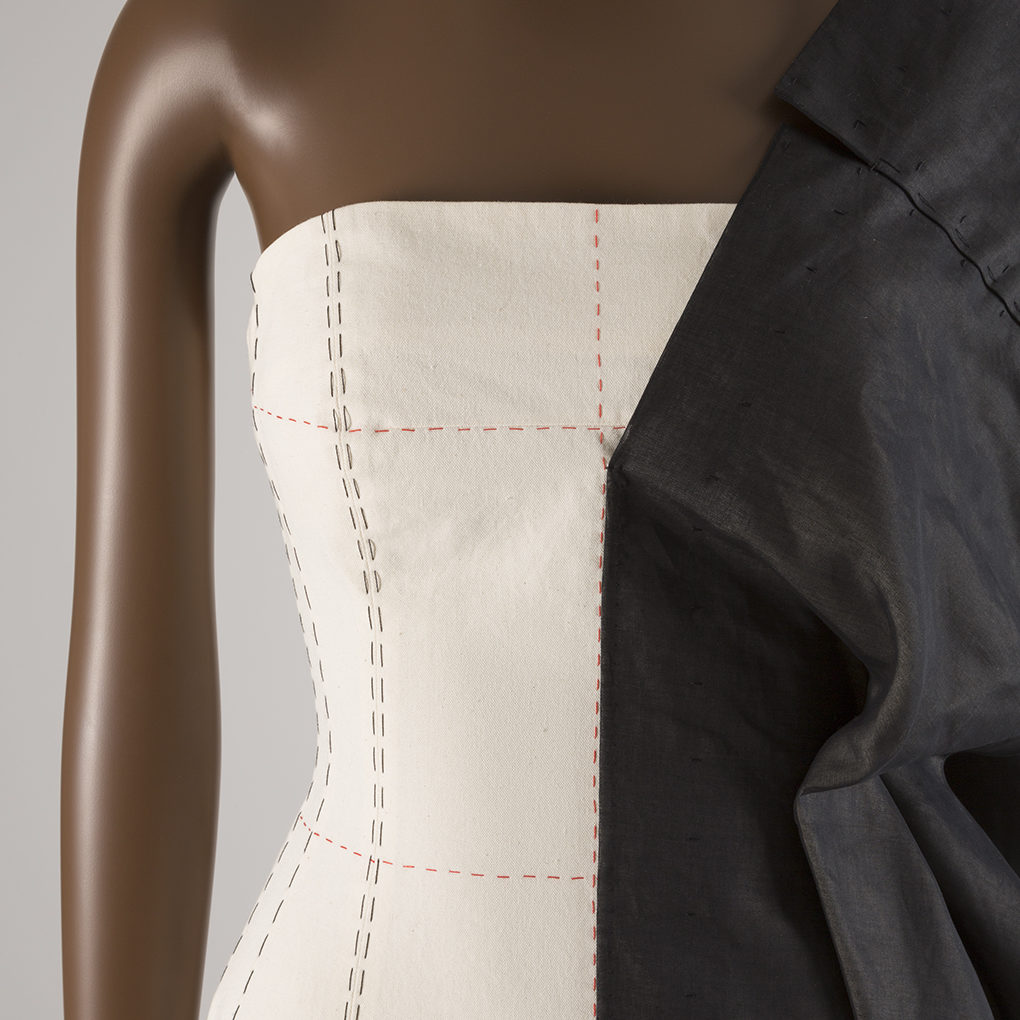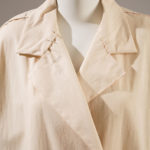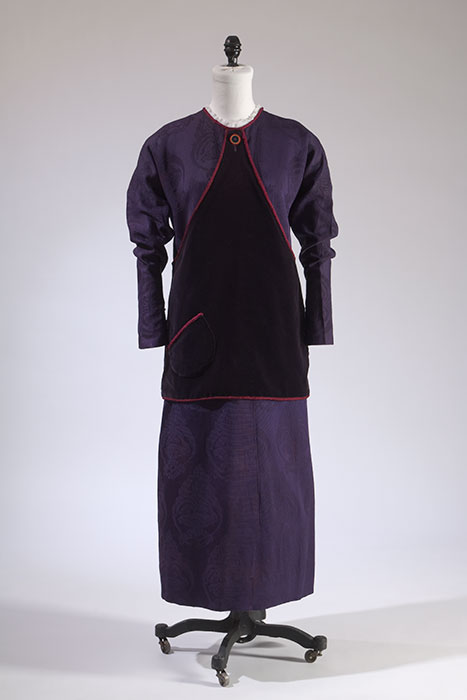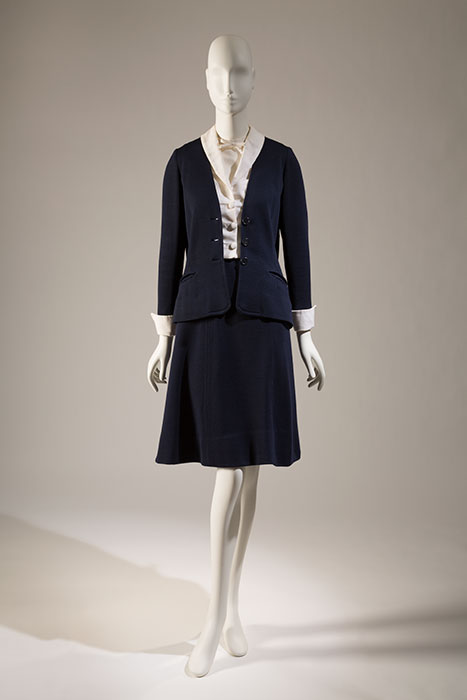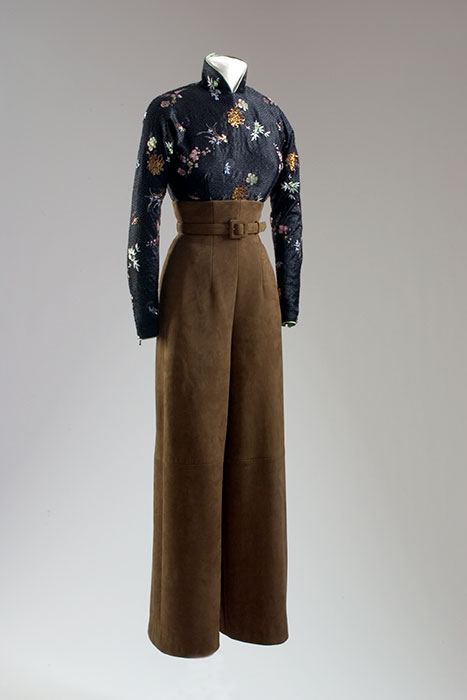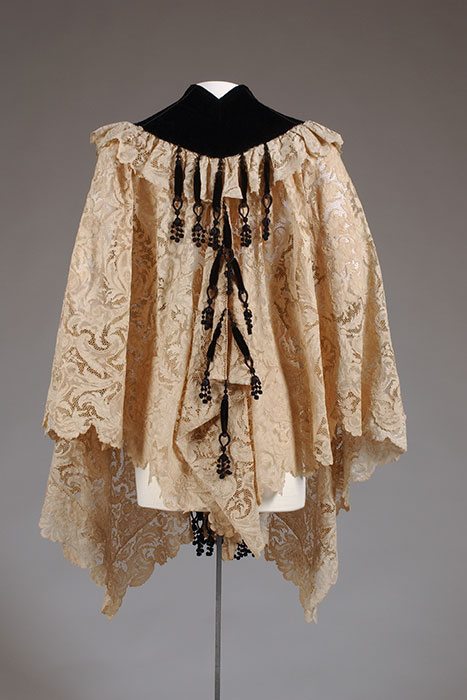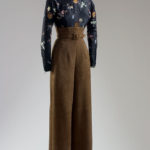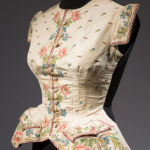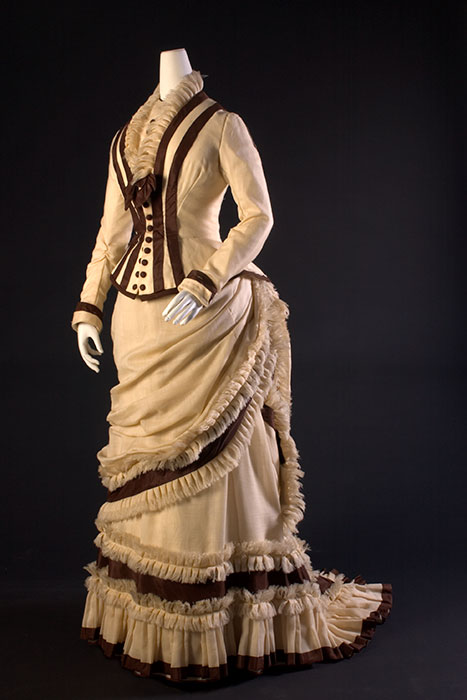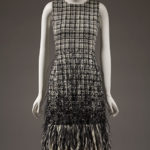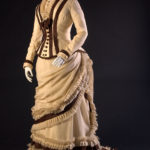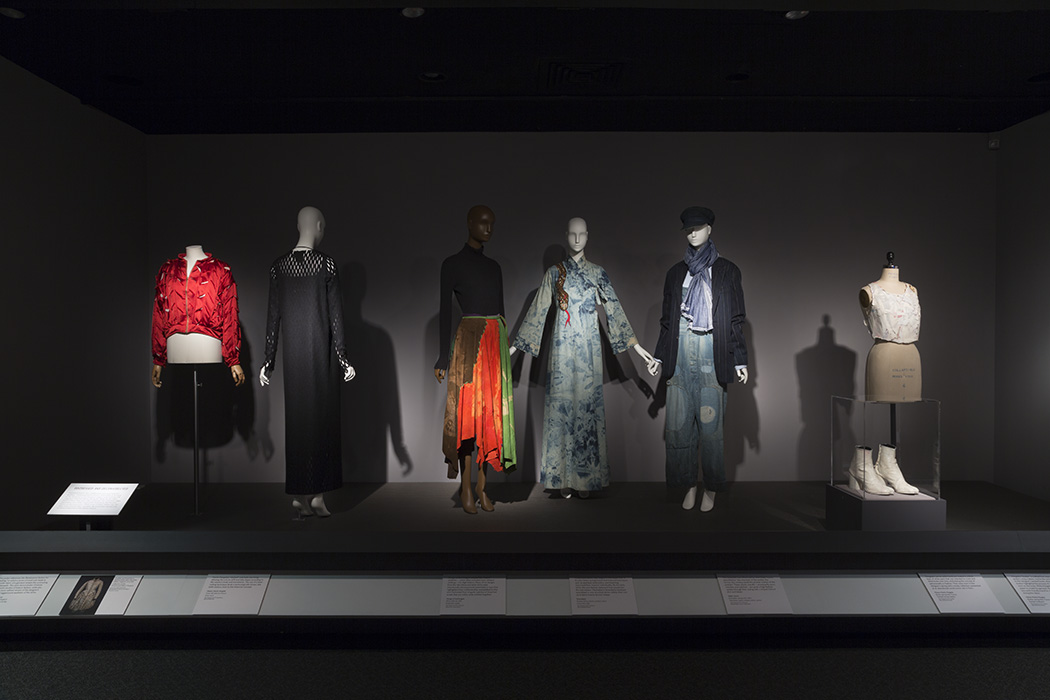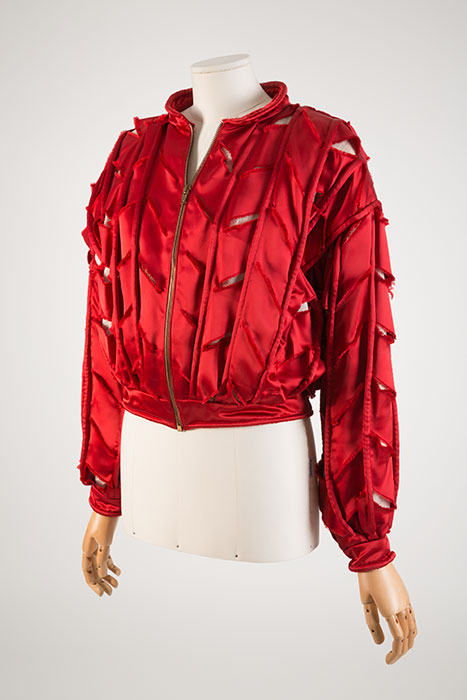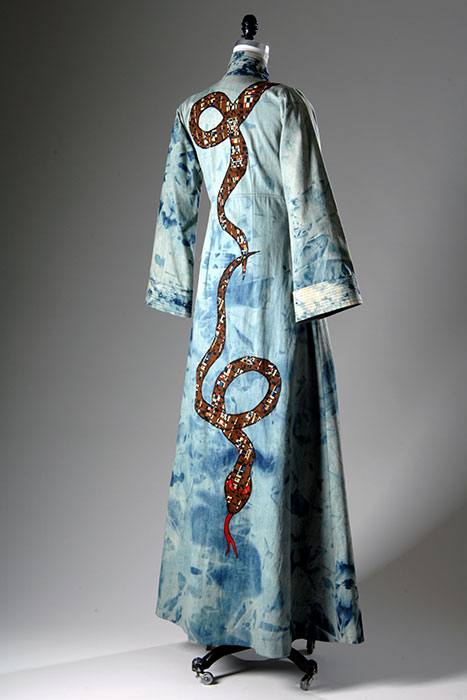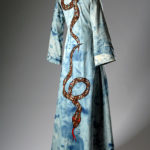Intro
Many visitors to fashion exhibitions expect to see only garments in perfect condition that exemplify a theme, a time period, or a designer’s aesthetic. Yet this would contradict one of the most basic facts about clothing: that it is designed to be worn, and in some cases, has been worn out. By means of the expert work of a conservator, a gallery’s low lighting, or the strategic placement of a garment at a concealing angle, flaws are often cleverly obscured and left unmentioned. Clothing with traces of wear that cannot be ignored or disguised tends not to be exhibited.
Fashion Unraveled takes a different approach by examining the concepts of imperfection, incompletion, and memory in fashion. More than sixty objects, dating from the 18th century to the present, are organized into five themes. “Behind the Seams” provides anecdotes on a garment’s creation or the way it was worn. “Mended and Altered” focuses on the varied and sometimes imperceptible ways a garment was modified over its history, while “Repurposed” features clothing that has been entirely remade. “Unfinished” addresses garments that are incomplete, either by chance or by choice. Finally, “Distressed and Deconstructed” discusses the ways in which designers have consciously embraced an aesthetic of imperfection in their work. All of the featured objects question our preconceived notions of beauty and value in fashion, and shed light on the importance of the stories that can be told by the garments themselves.
-
Image InfoClose
Intro Installation View
-
Image InfoClose
Yohji Yamamoto Dress
Yohji Yamamoto’s design employs red and black topstitching on muslin to replicate the look of basting stitches, while the loosely draped, asymmetrical overlay in black cotton furthers the illusion of a work in progress. Yamamoto’s inspiration for this collection came from his study of toiles by another great designer, Charles James.
Off-white cotton muslin, black cotton, spring 2000, Japan, 2010.37.5, museum purchase
-
Image InfoClose
Cristóbal Balenciaga Toile
A toile is a designer’s test garment. Typically made from muslin, it allows for experimentation with a new idea at little expense. This extant example by Cristóbal Balenciaga offers a rare and fascinating glimpse into the dressmaking process. It retains the couturier’s original pencil markings and is held together in some places only by pins.
Unbleached cotton muslin, circa 1958, France
Behind The Seams
Clothing brought into The Museum at FIT collection sometimes arrives with tales about its maker, its wearer, or its historical significance. While these anecdotes are documented and stored within the museum’s database, they are not always referenced when a garment is put on exhibition. The ensembles featured here were selected for their intriguing and varied narratives, none of which are immediately apparent.
-
Image InfoClose
Behind the Seams Installation View
-
Image InfoClose
Mad Carpentier Ensemble
The unusual outerwear ensemble was purchased in Paris just after World War II. Fabric shortages account for the mismatched pattern of the fabric on the coat, and only the cape is lined. It is possible that the garments were cut from a blanket — a common type of material reuse during the war years.
Blue tartan wool, 1946, France, 82.15.2, gift of Henriette Suhr.
-
Image InfoClose
Jean Dessès Evening dress
The donor of this evening dress modeled for Jean Dessès. She noted that she wore the gown in the designer’s August 1956 couture presentation, that it was crafted from 66 yards of chiffon, and that it was priced at $15,000. Curators rarely receive such important and detailed information on a historic garment.
Lavender and yellow silk chiffon, 1956, France, 96.112.1, gift of Lady Arlene Kieta
Mended And Altered
Many objects within museum fashion collections show signs of mending and alterations, but these are not always visible at first glance. Historically, the economic value of clothing and textiles ensured their scrupulous, long-term maintenance, but there are myriad reasons that a garment may have been modified. These include adaptations to keep pace with a newly fashionable silhouette, changes for use in theater or for other types of costume, and upkeep for sentimental reasons.
-
Image InfoClose
Mended and Altered Installation View
-
Image InfoClose
Mended and Altered Installation View
-
Image InfoClose
Stays
These stays were enlarged by adding panels of a different fabric at the waist. While this alteration may have been made to suit the changed figure of its original wearer, it is also possible that the stays were passed down to someone else or sold in the secondhand market.
Multicolor brocaded silk, circa 1750, France, 68.144.14, gift of Miss Adele Simpson
-
Image InfoClose
Paul Poiret Mélodie dress
This dress belonged to Denise Poiret, wife and muse to the leading early 20th-century couturier Paul Poiret. While it is certain that the dress remained in the Poiret family until The Museum at FIT acquired it in 2008, the style has been altered. The button-front skirt was stitched closed, and the hem was shortened.
Purple silk damask, velvet, fuchsia silk, 1912, France, 2008.6.1, museum purchase
-
Image InfoClose
Shoes
These shoes highlight the skill of textile conservators, whose work is meant to be “invisible” and often goes unnoticed. While the right shoe is mostly untouched, the left shoe underwent extensive conservation. Treatments included vacuuming, steam humidification to relax the fabric and allow for its reshaping, and stabilization of loose areas of fabric with a sheer material known as crepeline.
Cream linen and multicolor silk embroidery, circa 1740, England, 2003.86.1, gift of Phyllis W. Ingersoll
-
Image InfoClose
Chanel Suit
Fashion photographer Louise Dahl-Wolfe purportedly bought one outfit for herself in Paris each season, and this purchase appears to have been a favorite. The blouse, cuffs, and skirt were replaced over time — a subtle testament to the longevity of the style.
Navy double wool, white cotton piqué, circa 1935, France, 76.53.1, gift of Louise Dahl Wolfe
-
Image InfoClose
Elsa Schiaparelli Suit
This two-piece suit was donated to the museum in three pieces. Its original waistband was removed and the jacket, though intact, had been let out at the side seams. The skillful work of a conservator restored the garments to their original silhouettes. While it is known that Vogue editor Marcella McGuane wore the suit, the reason for its alteration is unclear.
Black and red wool, circa 1937, France, 87.70.1, gift of Theodora Pierce
-
Image InfoClose
Arnold Scaasi Cocktail ensemble
Arnold Scaasi’s bold cocktail ensemble appears pristine at first glance, but the design was cleverly modified by its wearer. The top portion of the shawl was skillfully removed and refashioned into a fringed belt, adding greater emphasis to the waist.
Liberty of London printed silk, 1961, USA, 75.92.1, gift of Mrs. Alfred Freen
Repurposed
Repurposed garments have been made from existing garments or textiles into something new, and such designs highlight the resourcefulness of their makers and the lasting value of the material. Although these garments tend to differ greatly from their initial form, their origins can usually be identified. Today, repurposing is a critical component of the sustainable fashion movement and is typically referred to as “upcycling.”
-
Image InfoClose
Repurposed Installation View
-
Image InfoClose
Man’s robe
This dressing gown was cut from a 19th-century crazy quilt — an object that already had been made from leftover scraps of fabric. The quilt may have been a dilapidated, otherwise unusable, family heirloom. Its conversion into a robe in 1935 demonstrates a clever reuse of materials during the Great Depression.
Multicolor patchwork, black moiré rayon, 1935, USA, 90.111.4, gift of Jack Peterkin
-
Image InfoClose
Anne Valérie Hash Dress
This dress was remade from a pair of man’s trousers. Rather than disguising the garment’s origins, Anne Valérie Hash left the original waistband intact and converted the pocket linings into sleeves. The result is contemporary and experimental, but it is also reminiscent of “make do and mend” techniques prevalent during the World War II era.
Brown wool tweed, light gray cotton, fall 2007, France, 2014.47.1, gift of Anne Valérie Hash
-
Image InfoClose
Rick Owens Jacket
Rick Owens’s early designs were often made from inexpensive materials he salvaged from thrift shops and army surplus stores. Jackets such as this one were handmade from deconstructed army bags. Speaking about the process of hand craftsmanship, the designer explained, “When you are an experimental label, there has to be a humanness in everything you do.”
Olive drab cotton duck, 1998, USA, 2006.25.1, gift of Rebecca Pietri
-
Image InfoClose
Jean Paul Gaultier Couture evening ensemble
This ensemble features a garment known as a qi pao converted into a bodysuit, exemplifying Jean Paul Gaultier’s interest in Chinese fashion. The antique silk of the original qi pao was heavily beaded by artisans in the designer’s atelier. Gaultier regularly repurposes cast-off garments to create one-of-a-kind designs.
Bodysuit: black patterned and beaded silk
Trousers: brown suede
fall 2001, France, 2005.68.2, museum purchase -
Image InfoClose
Maison Martin Margiela Jacket
Numerous designers experimented with repurposing materials during the 1990s, but fashion editor Suzy Menkes called Martin Margiela “fashion’s founding father of recycling.” She also observed that “this secondhand stuff [was] partly a guilt trip — fashion’s purging of the excesses of the 1980s.” The jacket featured here is remade from antique brocade of unknown origin.
Black brocade, sequins, braid, purple satin, and packing tape, spring 1993, 97.45.5, gift from the private collection of Mrs. Rebecca Pietri
-
Image InfoClose
Betsey Johnson Jumpsuit
Betsey Johnson designed, made, and wore this jumpsuit. Its colorful patches of striped fabric were cut from rugby shirts worn by John Cale, who was then the designer’s husband and a member of the rock band The Velvet Underground. Johnson remains known for her vibrant and eclectic aesthetic.
Multicolor cotton jersey, 1966, USA, 90.173.1, gift of Betsey Johnson
-
Image InfoClose
Lawrence Scott Suit
Lawrence Scott constructed this stylish suit from large pieces of old feed sacks. He chose to utilize traditional feed sacks rather than the fashionably printed, mid-century bags in order to call attention to their origin. Scott’s design exemplifies the increasing importance of recycling during the 1990s — a notion that extended to fashion production.
Printed cotton, 1994, USA, 95.13.1, gift of Lawrence Scott
-
Image InfoClose
Cifonelli Suit
This bespoke suit is made from the reverse of a paisley shawl. Generally employed to extend the life of a stained or faded fabric, the technique of reversing fabrics, called “turning,” has been documented as far back as the 18th century. In this example, it may have simply added texture and visual interest.
Paisley wool, 1960, Italy, 90.149.32, gift of Mr. Jean Françoise Daigre
-
Image InfoClose
Vest
The post-World War II era is often associated with increased consumerism, making this repurposed vest an interesting anomaly. It was cut and tailored from an 18th-century man’s waistcoat to suit a woman’s figure. The waistcoat’s fine silk and embroidery would have surpassed the quality of most modern clothing, perhaps explaining the appeal of its reuse.
Ivory silk with multicolor embroidery, circa 1950, USA, 89.54.2, gift of Sylvia Slifka
-
Image InfoClose
The House of Worth Cape
Esteemed 19th-century couturier Charles Frederick Worth was known for his use of luxurious fabrics. He repurposed a length of 18th-century lace to make this cape — a distinct change from the newly woven Lyonnaise silks he selected for many of his designs. Worth’s use of antique textiles underscored his appreciation for historic dress.
Cream linen lace, black silk velvet, chenille fringe, circa 1890, France, 69.160.9, gift of the Estate of Elizabeth Arden
-
Image InfoClose
Dress
The silk of this dress dates to circa 1760, while its silhouette dates to around 1840. Modifications to the original design include a bodice that was turned back-to-front, the addition of a pointed waistband, and a gathered neckline. The original sleeve ruffles were preserved and can be viewed in the nearby case.
Ivory silk, circa 1840, England, P87.20.7, museum purchase
-
Image InfoClose
Mimi Prober Dress
Mimi Prober’s ethereal creations are meticulously fashioned from secondhand textiles, creating what she describes as “modern handcrafted heirlooms.” In this example on the right, an old corset has been reworked into a bodice and paired with a skirt made from antique lace, its flaws concealed by pigment derived from discarded flowers.
Antique corset and lace, spring 2018, USA, 2018.13.1, gift of Mimi Prober
Unfinished
Unfinished garments initially may not seem worthy of inclusion in a museum collection, but they can provide fascinating information about the processes of making fashion. Such objects sometimes take the form of samples, which are intended to test design ideas and prepare them for production. Today, an unfinished look — often in the form of frayed edges — is fashionable even among high-end designers.
-
Image InfoClose
Hans Schreiber Spiral Gown (LEFT)
Hans Schreiber attended the Royal Academy of Fine Arts in Antwerp, Belgium — the school that famously trained Martin Margiela and other “desconstructivist” designers. While Schreiber’s Spiral gown is carefully constructed from layers of multicolored chiffon, a hint of disarray is evident in the frayed edges that elegantly overlap at the gown’s neck, armholes, and hem.Multicolor silk chiffon, 1992-93, Germany, 96.39.2, gift of Hans Schreiber
Yeohlee bodysuit and Zero Waste sarong (RIGHT)
This sarong was made from lengths of organza that were stitched, folded, and wrapped around the body in a manner that wasted not even a scrap of material. Yeohlee’s non-intrusive approach to the use of fabric also extended to her frayed, unfinished hems that fan out and emphasize the gossamer quality of the fabric.Black jersey, organza, fall 2009, USA, 2010.44.1, gift of Yeohlee Teng, Yeohlee
-
Image InfoClose
Unfinished Installation View
-
Image InfoClose
Oscar de la Renta Cocktail dress
Oscar de la Renta’s cocktail dress exemplifies how the “ragged” appearance of unraveled fabric has become fully incorporated into high fashion. The artful disarray of the dense fringe at the skirt’s hem — created from strands of unwoven wool tweed — is countered by the conventional opulence of the beads, rhinestones, and ostrich feathers.
Black and white wool tweed, ostrich feathers, beads, rhinestones, 2002, USA, 2017.67.1, gift of Elizabeth Graham Weymouth
-
Image InfoClose
Dress
This bustle gown is embellished with an unusual, raw-edged trim — but what is even more intriguing is that the design was never completed. In several areas, the trim remains basted on rather than properly stitched. Women’s clothing was costly during the 19th century, and it is rare to find an example left in the process of creation.
Ivory wool, brown silk taffeta, circa 1880, USA, P86.66.1, museum purchase
-
Image InfoClose
Geoffrey Beene Dress (LEFT)
Geoffrey Beene accentuated this intricately woven cotton fabric by literally bringing its fringed edges to the front and center of his design. Textile selection was essential to the designer, who once stated, “Design begins with concept and drape. I handle the fabric, which is the dictate of what shape and form will permit.”Beige and black woven cotton, circa 1968, USA, 80.19.7, gift of Adelaide Burr Oursler
Issey Miyake Ensemble (Right)
Issey Miyake’s work of the early 1980s was often influenced by the traditional work clothes worn by Japanese peasants, carpenters, and other laborers. Textiles with a homespun appearance were integral to this aesthetic. The frayed-edged trim selected for this ensemble highlights the designer’s innovative, asymmetrical design.Beige wool, 1982, Japan, 93.46.7, gift of Ms. Sunatha Tan
Distressed And Deconstructed
Distressed fashion has a deliberately worn and imperfect aesthetic. Slashed garments became fashionable as far back as the Renaissance, and designers began experimenting with irregularly bleached fabrics during the 1960s. By the 1980s, both of these ideas were often combined with unfinished edges, asymmetry, and visible construction techniques that became known as deconstruction. While some of these clothes may still seem more extreme than wearable, deconstruction has become a critical component of the fashion lexicon.
-
Image InfoClose
Distressed And Deconstructed Installation View
-
Image InfoClose
Vivienne Westwood Jacket
This jacket references the Renaissance fashion for “slashing,” in which a series of small cuts made to the outer fabric of a garment reveals the contrasting lining beneath. This style demonstrates Vivienne Westwood’s studies of historic fashion, while also offering a more refined version of the designer’s ripped and ragged punk aesthetic of the 1970s.
Red rayon satin, white burlap, spring 1991, England, 98.140.1, museum purchase
-
Image InfoClose
Maison Martin Margiela Boots
Margiela’s canvas ankle boots are coated in a thick layer of white paint that was intended to continually crack and deteriorate over time, embodying the concept of ephemerality in fashion. They were worn in the designer’s spring 1990 runway collection, presented at an abandoned construction site in Paris.
Painted canvas, leather, spring 1990, France, 92.182.1, gift of Richard Martin
-
Image InfoClose
Giorgio di Sant’Angelo Skirt
Giorgio di Sant’Angelo adapted the “hippie” aesthetic — which often included worn, antique clothing — into high fashion. Many of his designs from the late 1960s and early 1970s were intentionally distressed and assembled in ways that highlighted their craftsmanship, exemplified by this skirt fashioned from irregular patches of bleached suede that are visibly whip-stitched together.
Multicolor suede, 1968-69, USA, 91.254.23, gift of Mrs. Lena Horne
-
Image InfoClose
Comme des Garçons T-shirt
Design critic Deyan Sudjic described Rei Kawakubo’s early designs as “abstraction of fashion into the fundamentals of texture, form and color.” Although her T-shirt was meticulously constructed, its asymmetrical pieces appear to be haphazardly assembled, leaving gaps and unfinished edges. A dress-length version of this garment retailed for $230 (nearly $600 today).
Black cotton knit, 1983, Japan, 90.98.69, gift of Ms. Terry Melville
-
Image InfoClose
Serendipity Hostess dress
Customized denim was integral to the hippie look of the late 1960s, and garments that featured techniques such as appliqué, embroidery, and bleaching expressed their wearers’ individuality. By the early 1970s, this anti-fashion statement had moved into the mainstream. Manhattan’s Serendipity boutique specialized in one-of-a-kind denim clothes that cost up to $500 (nearly $3,000 today).
Denim, printed cotton, circa 1972, USA, 78.100.8, gift of Stephen Bruce
-
Image InfoClose
Lanvin (Alber Elbaz) Dress
The outer layers of fabric in this dress appear to be unfolding around the body, suggesting that the design is either a work-in-progress or coming apart. Despite this deconstructed approach to dressmaking, Alber Elbaz’s skill for draping resulted in a look that is more elegant than it is disheveled.
Pink cotton, cotton satin, organza, spring 2010, France, 2011.2.1, gift of Lanvin

